fuel pressure FORD SIERRA 1992 2.G Routine Manintenance And Servicing Workshop Manual
[x] Cancel search | Manufacturer: FORD, Model Year: 1992, Model line: SIERRA, Model: FORD SIERRA 1992 2.GPages: 22, PDF Size: 1.26 MB
Page 2 of 22

Cooling system
Drivebelt tensions:
Air conditioning system compressor . . . . . . . . . . . . . . . . . . . . . . . . .10.0 mm (0.4 in) deflection at the midpoint of the belt’s longest run
under firm thumb pressure
Coolant pump/alternator . . . . . . . . . . . . . . . . . . . . . . . . . . . . . . . . . .10.0 mm (0.4 in) deflection midway between coolant pump and
alternator (or power steering pump) pulleys under firm thumb pressure
Fuel system
Air filter element:
Carburettor type:
1.3 and 1.6 litre (SOHC - Ford carburettor) . . . . . . . . . . . . . . . . . .Champion W110
1.6 litre (SOHC - Weber carburettor) and 1.8 litre SOHC . . . . . . . .Champion W118
1.6 litre (SOHC - 1984-on) and 2.0 litre SOHC . . . . . . . . . . . . . . . .Champion W152
1.8 litre CVH . . . . . . . . . . . . . . . . . . . . . . . . . . . . . . . . . . . . . . . . . .Champion W219
2.0 litre DOHC . . . . . . . . . . . . . . . . . . . . . . . . . . . . . . . . . . . . . . . . .Champion W152
Fuel injection type:
2.0 litre SOHC and DOHC . . . . . . . . . . . . . . . . . . . . . . . . . . . . . . . .Champion U507
1.6 and 1.8 litre (R6A type) CVH . . . . . . . . . . . . . . . . . . . . . . . . . . .Champion W219
Fuel filter:
All fuel injection models . . . . . . . . . . . . . . . . . . . . . . . . . . . . . . . . . . .Champion L204
Ignition system
Spark plugs:
Make and type:
All except 1.8 CVH, CVH (R6A), 2.0 DOHC and P100 . . . . . . . . . . . .Champion RF7YCC or RF7YC
1.8 litre CVH . . . . . . . . . . . . . . . . . . . . . . . . . . . . . . . . . . . . . . . . . . . .Champion RC7YCC or RC7YC
P100 . . . . . . . . . . . . . . . . . . . . . . . . . . . . . . . . . . . . . . . . . . . . . . . . . .Champion RF7YC or F7YC
1.6 and 1.8 litre (R6A type) CVH . . . . . . . . . . . . . . . . . . . . . . . . . . . . .Champion RC7YCC
2.0 litre DOHC . . . . . . . . . . . . . . . . . . . . . . . . . . . . . . . . . . . . . . . . . . .Champion RC7YCC
Electrode gap*:
Champion F7YCC or RC7YCC . . . . . . . . . . . . . . . . . . . . . . . . . . . . . .0.8 mm (0.032 in)
Champion RF7YC, F7YC or RC7YC . . . . . . . . . . . . . . . . . . . . . . . . . .0.7 mm (0.028 in)
Ignition HT leads
Resistance . . . . . . . . . . . . . . . . . . . . . . . . . . . . . . . . . . . . . . . . . . . . . . .30 k ohms maximum per lead
Type:
All SOHC models . . . . . . . . . . . . . . . . . . . . . . . . . . . . . . . . . . . . . . . .Champion LS-09 or LS-10 boxed set
1.8 litre CVH . . . . . . . . . . . . . . . . . . . . . . . . . . . . . . . . . . . . . . . . . . . .Champion LS-10 boxed set
1.6 and 1.8 litre (R6A type) CVH . . . . . . . . . . . . . . . . . . . . . . . . . . . .Champion LS-30 boxed set
2.0 litre DOHC . . . . . . . . . . . . . . . . . . . . . . . . . . . . . . . . . . . . . . . . . . .Champion LS-29 boxed set
*The spark plug gap quoted is that recommended by Champion for their specified plugs listed above. If spark plugs of any other type are to be
fitted, refer to their manufacturer’s recommendations.
Brakes
Brake pad friction material minimum thickness . . . . . . . . . . . . . . . . . . .1.5 mm (0.06 in)
Brake shoe friction material minimum thickness . . . . . . . . . . . . . . . . . .1.0 mm (0.04 in)
Torque wrench settingsNmlbf ft
Engine oil drain plug:
SOHC and DOHC . . . . . . . . . . . . . . . . . . . . . . . . . . . . . . . . . . . . . . . .21 to 2816 to 21
CVH . . . . . . . . . . . . . . . . . . . . . . . . . . . . . . . . . . . . . . . . . . . . . . . . . . .20 to 3015 to 22
Engine block coolant drain plug (where fitted) . . . . . . . . . . . . . . . . . . . .21 to 25 16 to 18
Manual gearbox:
Oil filler/level plug:
A,B,C and N types . . . . . . . . . . . . . . . . . . . . . . . . . . . . . . . . . . . . .33 to 4124 to 30
MT75 type . . . . . . . . . . . . . . . . . . . . . . . . . . . . . . . . . . . . . . . . . . . .29 to 4121 to 30
Oil drain plug:
MT75 type . . . . . . . . . . . . . . . . . . . . . . . . . . . . . . . . . . . . . . . . . . . .29 to 4121 to 30
Final drive oil filler plug . . . . . . . . . . . . . . . . . . . . . . . . . . . . . . . . . . . . . .35 to 4526 to 33
Roadwheel nuts:
Saloon, Hatchback and Estate models (steel and alloy wheels) . . . .70 to 10052 to 74
P100 models . . . . . . . . . . . . . . . . . . . . . . . . . . . . . . . . . . . . . . . . . . . .85 to 9063 to 66
Spark plugs:
SOHC models . . . . . . . . . . . . . . . . . . . . . . . . . . . . . . . . . . . . . . . . . . .20 to 2815 to 21
CVH models . . . . . . . . . . . . . . . . . . . . . . . . . . . . . . . . . . . . . . . . . . . .18 to 3313 to 24
DOHC models . . . . . . . . . . . . . . . . . . . . . . . . . . . . . . . . . . . . . . . . . . .15 to 2111 to 15
Brake caliper guide bolts:
Front . . . . . . . . . . . . . . . . . . . . . . . . . . . . . . . . . . . . . . . . . . . . . . . . . .20 to 2515 to 18
Rear . . . . . . . . . . . . . . . . . . . . . . . . . . . . . . . . . . . . . . . . . . . . . . . . . . .31 to 3523 to 26
1•2Servicing specifications
Page 4 of 22
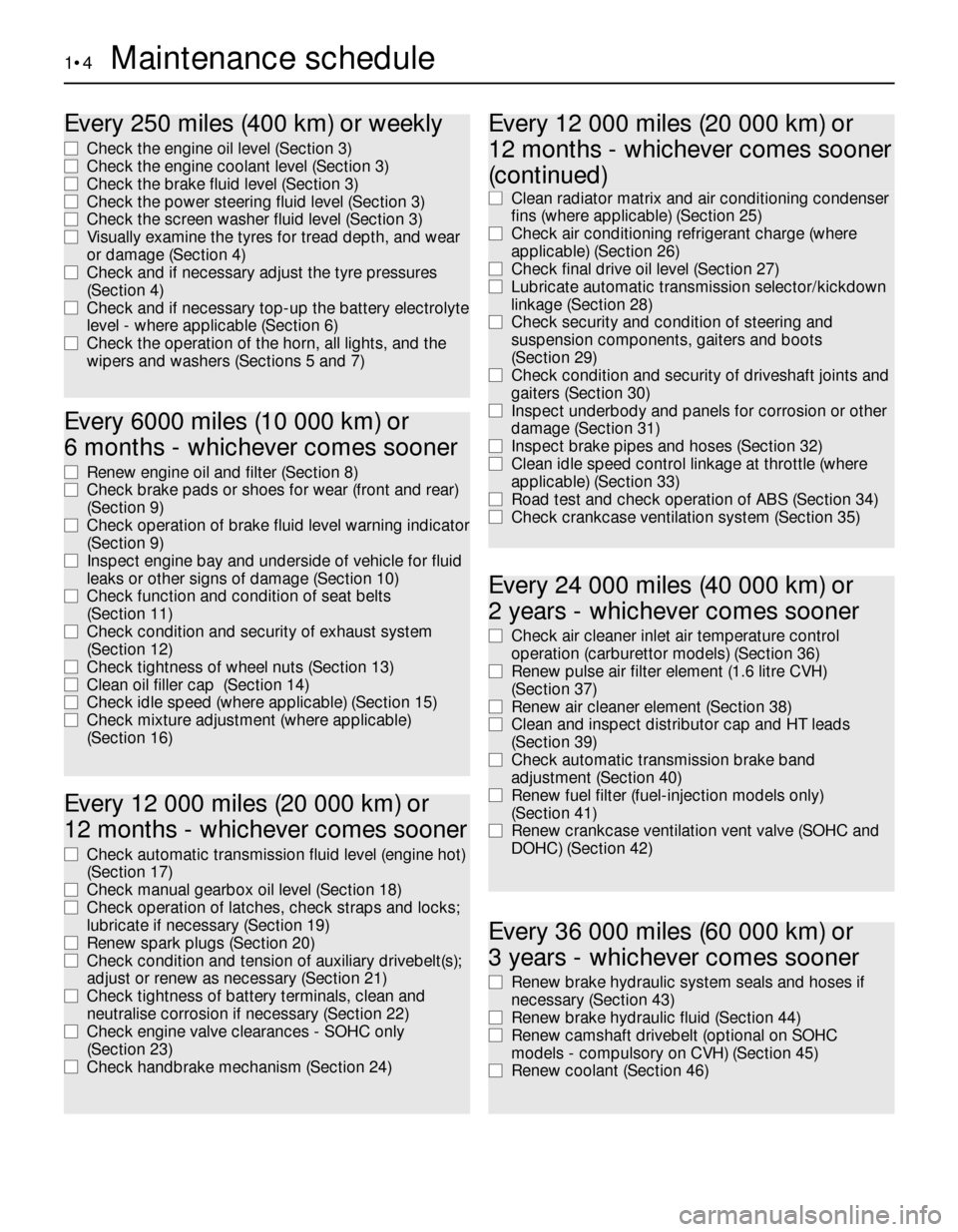
1•4Maintenance schedule
Every 250 miles (400 km) or weekly
m mCheck the engine oil level (Section 3)
m mCheck the engine coolant level (Section 3)
m mCheck the brake fluid level (Section 3)
m mCheck the power steering fluid level (Section 3)
m mCheck the screen washer fluid level (Section 3)
m mVisually examine the tyres for tread depth, and wear
or damage (Section 4)
m mCheck and if necessary adjust the tyre pressures
(Section 4)
m mCheck and if necessary top-up the battery electrolyte
level - where applicable (Section 6)
m mCheck the operation of the horn, all lights, and the
wipers and washers (Sections 5 and 7)
Every 6000 miles (10 000 km) or
6 months - whichever comes sooner
m mRenew engine oil and filter (Section 8)
m mCheck brake pads or shoes for wear (front and rear)
(Section 9)
m mCheck operation of brake fluid level warning indicator
(Section 9)
m mInspect engine bay and underside of vehicle for fluid
leaks or other signs of damage (Section 10)
m mCheck function and condition of seat belts
(Section 11)
m mCheck condition and security of exhaust system
(Section 12)
m mCheck tightness of wheel nuts (Section 13)
m mClean oil filler cap (Section 14)
m mCheck idle speed (where applicable) (Section 15)
m mCheck mixture adjustment (where applicable)
(Section 16)
Every 12 000 miles (20 000 km) or
12 months - whichever comes sooner
m mCheck automatic transmission fluid level (engine hot)
(Section 17)
m mCheck manual gearbox oil level (Section 18)
m mCheck operation of latches, check straps and locks;
lubricate if necessary (Section 19)
m mRenew spark plugs (Section 20)
m mCheck condition and tension of auxiliary drivebelt(s);
adjust or renew as necessary (Section 21)
m mCheck tightness of battery terminals, clean and
neutralise corrosion if necessary (Section 22)
m mCheck engine valve clearances - SOHC only
(Section 23)
m mCheck handbrake mechanism (Section 24)
Every 24 000 miles (40 000 km) or
2 years - whichever comes sooner
m mCheck air cleaner inlet air temperature control
operation (carburettor models) (Section 36)
m mRenew pulse air filter element (1.6 litre CVH)
(Section 37)
m mRenew air cleaner element (Section 38)
m mClean and inspect distributor cap and HT leads
(Section 39)
m mCheck automatic transmission brake band
adjustment (Section 40)
m mRenew fuel filter (fuel-injection models only)
(Section 41)
m mRenew crankcase ventilation vent valve (SOHC and
DOHC) (Section 42)
m mClean radiator matrix and air conditioning condenser
fins (where applicable) (Section 25)
m mCheck air conditioning refrigerant charge (where
applicable) (Section 26)
m mCheck final drive oil level (Section 27)
m mLubricate automatic transmission selector/kickdown
linkage (Section 28)
m mCheck security and condition of steering and
suspension components, gaiters and boots
(Section 29)
m mCheck condition and security of driveshaft joints and
gaiters (Section 30)
m mInspect underbody and panels for corrosion or other
damage (Section 31)
m mInspect brake pipes and hoses (Section 32)
m mClean idle speed control linkage at throttle (where
applicable) (Section 33)
m mRoad test and check operation of ABS (Section 34)
m mCheck crankcase ventilation system (Section 35)
Every 36 000 miles (60 000 km) or
3 years - whichever comes sooner
m mRenew brake hydraulic system seals and hoses if
necessary (Section 43)
m mRenew brake hydraulic fluid (Section 44)
m mRenew camshaft drivebelt (optional on SOHC
models - compulsory on CVH) (Section 45)
m mRenew coolant (Section 46)
Every 12 000 miles (20 000 km) or
12 months - whichever comes sooner
(continued)
Page 5 of 22
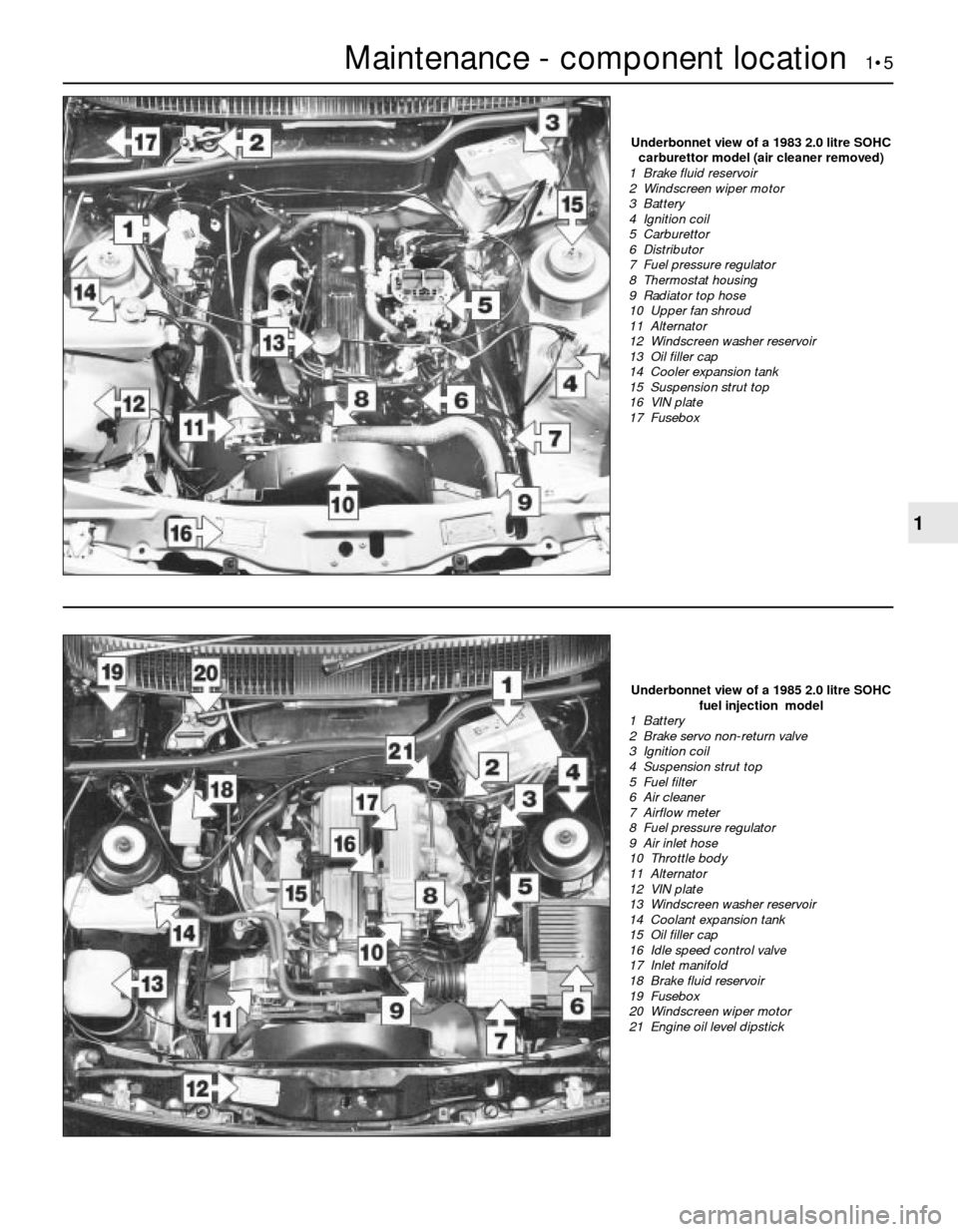
Maintenance - component location 1•5
1
Underbonnet view of a 1985 2.0 litre SOHC
fuel injection model
1 Battery
2 Brake servo non-return valve
3 Ignition coil
4 Suspension strut top
5 Fuel filter
6 Air cleaner
7 Airflow meter
8 Fuel pressure regulator
9 Air inlet hose
10 Throttle body
11 Alternator
12 VIN plate
13 Windscreen washer reservoir
14 Coolant expansion tank
15 Oil filler cap
16 Idle speed control valve
17 Inlet manifold
18 Brake fluid reservoir
19 Fusebox
20 Windscreen wiper motor
21 Engine oil level dipstick
Underbonnet view of a 1983 2.0 litre SOHC
carburettor model (air cleaner removed)
1 Brake fluid reservoir
2 Windscreen wiper motor
3 Battery
4 Ignition coil
5 Carburettor
6 Distributor
7 Fuel pressure regulator
8 Thermostat housing
9 Radiator top hose
10 Upper fan shroud
11 Alternator
12 Windscreen washer reservoir
13 Oil filler cap
14 Cooler expansion tank
15 Suspension strut top
16 VIN plate
17 Fusebox
Page 6 of 22
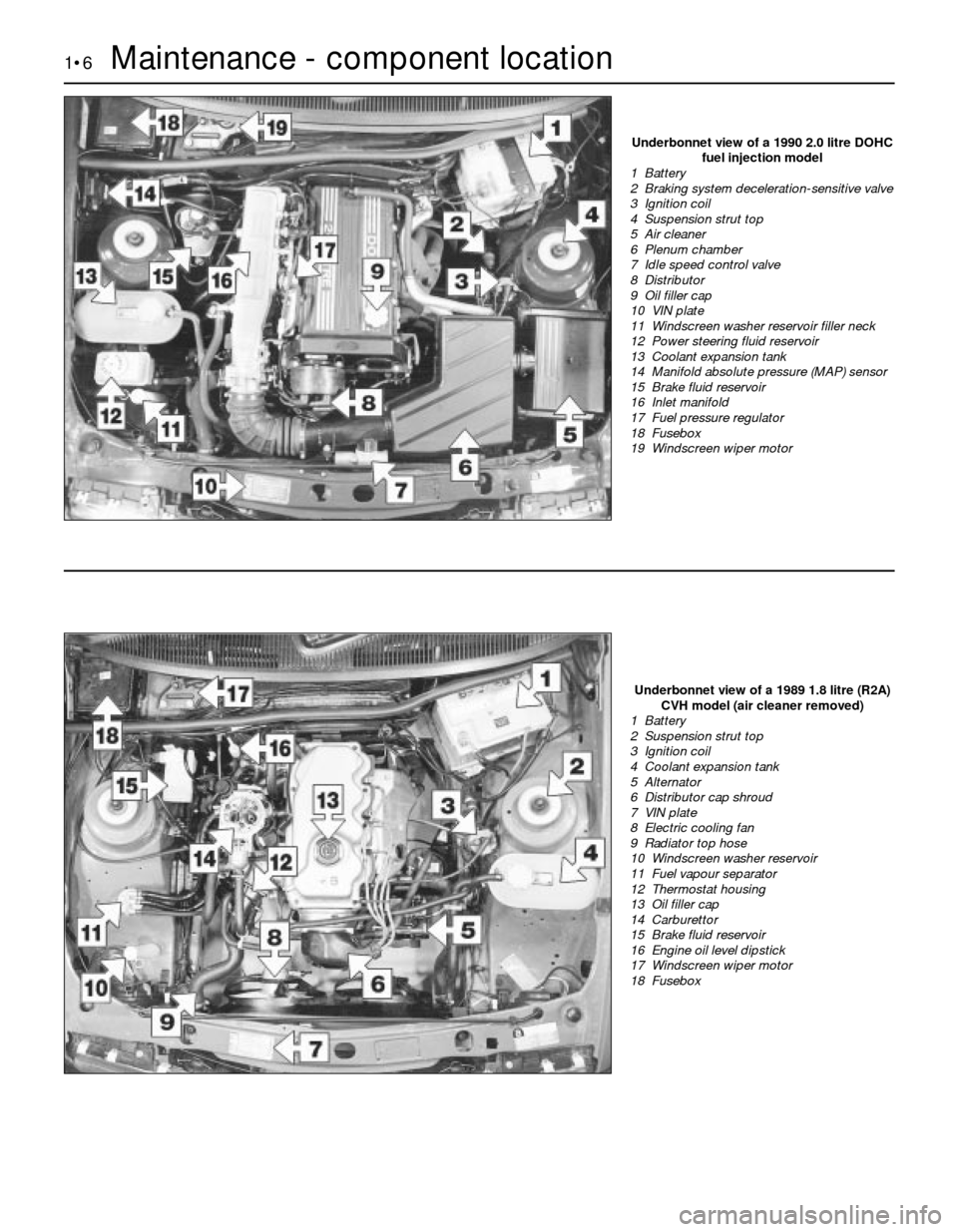
1•6Maintenance - component location
Underbonnet view of a 1990 2.0 litre DOHC
fuel injection model
1 Battery
2 Braking system deceleration-sensitive valve
3 Ignition coil
4 Suspension strut top
5 Air cleaner
6 Plenum chamber
7 Idle speed control valve
8 Distributor
9 Oil filler cap
10 VIN plate
11 Windscreen washer reservoir filler neck
12 Power steering fluid reservoir
13 Coolant expansion tank
14 Manifold absolute pressure (MAP) sensor
15 Brake fluid reservoir
16 Inlet manifold
17 Fuel pressure regulator
18 Fusebox
19 Windscreen wiper motor
Underbonnet view of a 1989 1.8 litre (R2A)
CVH model (air cleaner removed)
1 Battery
2 Suspension strut top
3 Ignition coil
4 Coolant expansion tank
5 Alternator
6 Distributor cap shroud
7 VIN plate
8 Electric cooling fan
9 Radiator top hose
10 Windscreen washer reservoir
11 Fuel vapour separator
12 Thermostat housing
13 Oil filler cap
14 Carburettor
15 Brake fluid reservoir
16 Engine oil level dipstick
17 Windscreen wiper motor
18 Fusebox
Page 11 of 22
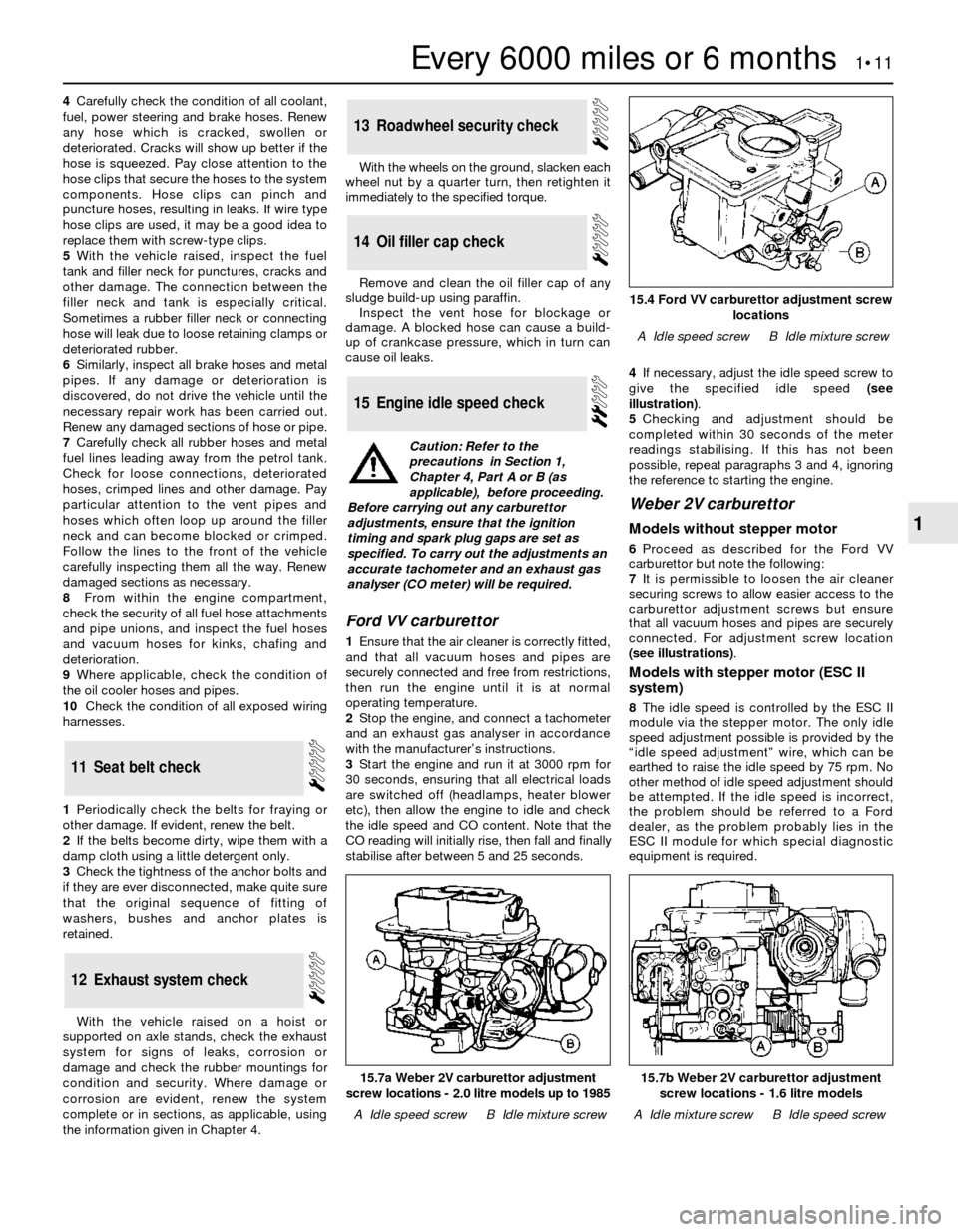
4Carefully check the condition of all coolant,
fuel, power steering and brake hoses. Renew
any hose which is cracked, swollen or
deteriorated. Cracks will show up better if the
hose is squeezed. Pay close attention to the
hose clips that secure the hoses to the system
components. Hose clips can pinch and
puncture hoses, resulting in leaks. If wire type
hose clips are used, it may be a good idea to
replace them with screw-type clips.
5With the vehicle raised, inspect the fuel
tank and filler neck for punctures, cracks and
other damage. The connection between the
filler neck and tank is especially critical.
Sometimes a rubber filler neck or connecting
hose will leak due to loose retaining clamps or
deteriorated rubber.
6Similarly, inspect all brake hoses and metal
pipes. If any damage or deterioration is
discovered, do not drive the vehicle until the
necessary repair work has been carried out.
Renew any damaged sections of hose or pipe.
7Carefully check all rubber hoses and metal
fuel lines leading away from the petrol tank.
Check for loose connections, deteriorated
hoses, crimped lines and other damage. Pay
particular attention to the vent pipes and
hoses which often loop up around the filler
neck and can become blocked or crimped.
Follow the lines to the front of the vehicle
carefully inspecting them all the way. Renew
damaged sections as necessary.
8From within the engine compartment,
check the security of all fuel hose attachments
and pipe unions, and inspect the fuel hoses
and vacuum hoses for kinks, chafing and
deterioration.
9Where applicable, check the condition of
the oil cooler hoses and pipes.
10Check the condition of all exposed wiring
harnesses.
1Periodically check the belts for fraying or
other damage. If evident, renew the belt.
2If the belts become dirty, wipe them with a
damp cloth using a little detergent only.
3Check the tightness of the anchor bolts and
if they are ever disconnected, make quite sure
that the original sequence of fitting of
washers, bushes and anchor plates is
retained.
With the vehicle raised on a hoist or
supported on axle stands, check the exhaust
system for signs of leaks, corrosion or
damage and check the rubber mountings for
condition and security. Where damage or
corrosion are evident, renew the system
complete or in sections, as applicable, using
the information given in Chapter 4.With the wheels on the ground, slacken each
wheel nut by a quarter turn, then retighten it
immediately to the specified torque.
Remove and clean the oil filler cap of any
sludge build-up using paraffin.
Inspect the vent hose for blockage or
damage. A blocked hose can cause a build-
up of crankcase pressure, which in turn can
cause oil leaks.
Ford VV carburettor
1Ensure that the air cleaner is correctly fitted,
and that all vacuum hoses and pipes are
securely connected and free from restrictions,
then run the engine until it is at normal
operating temperature.
2Stop the engine, and connect a tachometer
and an exhaust gas analyser in accordance
with the manufacturer’s instructions.
3Start the engine and run it at 3000 rpm for
30 seconds, ensuring that all electrical loads
are switched off (headlamps, heater blower
etc), then allow the engine to idle and check
the idle speed and CO content. Note that the
CO reading will initially rise, then fall and finally
stabilise after between 5 and 25 seconds.4If necessary, adjust the idle speed screw to
give the specified idle speed (see
illustration).
5Checking and adjustment should be
completed within 30 seconds of the meter
readings stabilising. If this has not been
possible, repeat paragraphs 3 and 4, ignoring
the reference to starting the engine.
Weber 2V carburettor
Models without stepper motor
6Proceed as described for the Ford VV
carburettor but note the following:
7It is permissible to loosen the air cleaner
securing screws to allow easier access to the
carburettor adjustment screws but ensure
that all vacuum hoses and pipes are securely
connected. For adjustment screw location
(see illustrations).
Models with stepper motor (ESC II
system)
8The idle speed is controlled by the ESC II
module via the stepper motor. The only idle
speed adjustment possible is provided by the
“idle speed adjustment” wire, which can be
earthed to raise the idle speed by 75 rpm. No
other method of idle speed adjustment should
be attempted. If the idle speed is incorrect,
the problem should be referred to a Ford
dealer, as the problem probably lies in the
ESC II module for which special diagnostic
equipment is required.
15Engine idle speed check
14Oil filler cap check
13Roadwheel security check
12Exhaust system check
11Seat belt check
Every 6000 miles or 6 months 1•11
1
15.7b Weber 2V carburettor adjustment
screw locations - 1.6 litre models
A Idle mixture screwB Idle speed screw
15.7a Weber 2V carburettor adjustment
screw locations - 2.0 litre models up to 1985
A Idle speed screwB Idle mixture screw
15.4 Ford VV carburettor adjustment screw
locations
A Idle speed screwB Idle mixture screw
Caution: Refer to the
precautions in Section 1,
Chapter 4, Part A or B (as
applicable), before proceeding.
Before carrying out any carburettor
adjustments, ensure that the ignition
timing and spark plug gaps are set as
specified. To carry out the adjustments an
accurate tachometer and an exhaust gas
analyser (CO meter) will be required.
Page 20 of 22
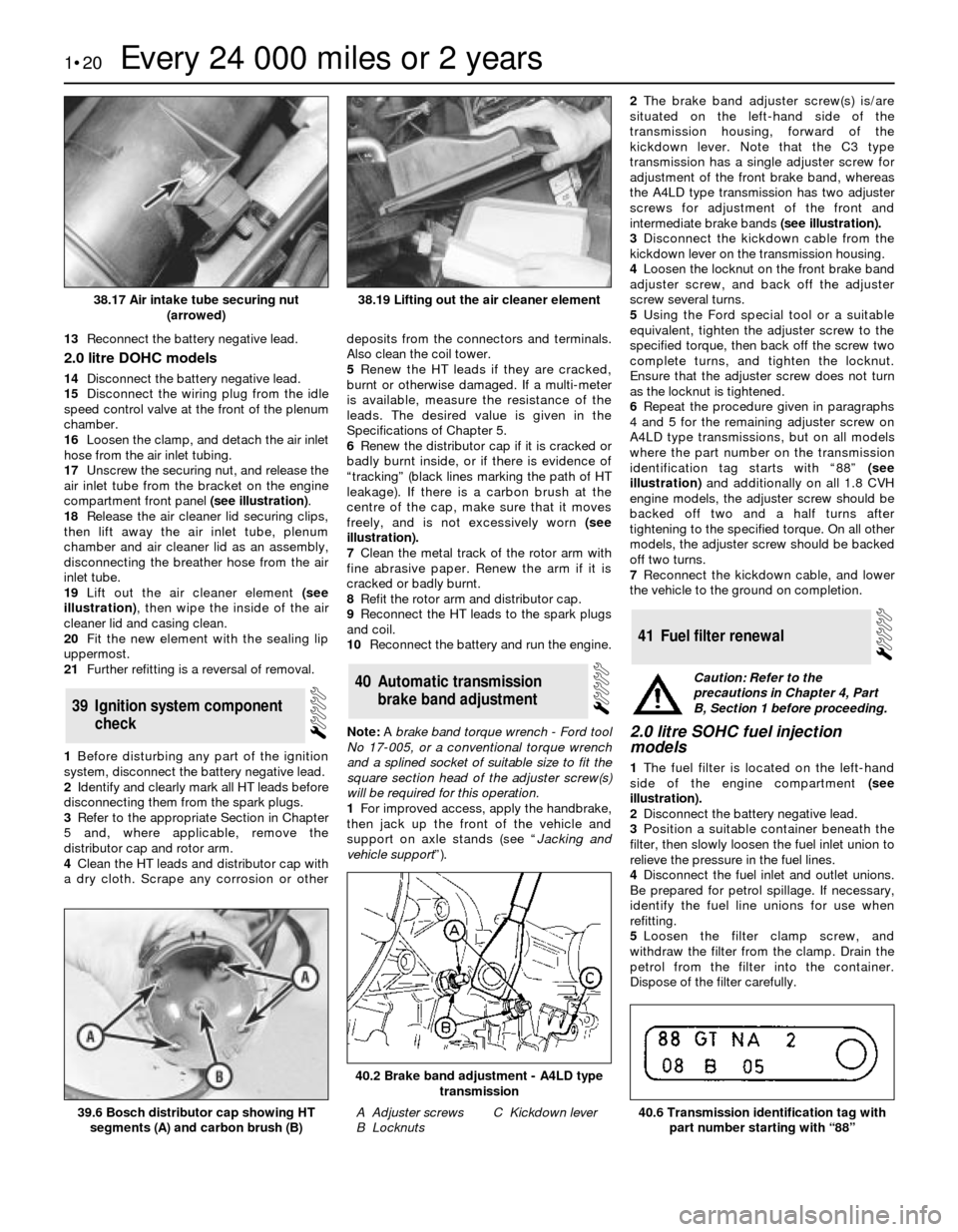
13Reconnect the battery negative lead.
2.0 litre DOHC models
14Disconnect the battery negative lead.
15Disconnect the wiring plug from the idle
speed control valve at the front of the plenum
chamber.
16Loosen the clamp, and detach the air inlet
hose from the air inlet tubing.
17Unscrew the securing nut, and release the
air inlet tube from the bracket on the engine
compartment front panel (see illustration).
18Release the air cleaner lid securing clips,
then lift away the air inlet tube, plenum
chamber and air cleaner lid as an assembly,
disconnecting the breather hose from the air
inlet tube.
19Lift out the air cleaner element (see
illustration), then wipe the inside of the air
cleaner lid and casing clean.
20Fit the new element with the sealing lip
uppermost.
21Further refitting is a reversal of removal.
1Before disturbing any part of the ignition
system, disconnect the battery negative lead.
2Identify and clearly mark all HT leads before
disconnecting them from the spark plugs.
3Refer to the appropriate Section in Chapter
5 and, where applicable, remove the
distributor cap and rotor arm.
4Clean the HT leads and distributor cap with
a dry cloth. Scrape any corrosion or otherdeposits from the connectors and terminals.
Also clean the coil tower.
5Renew the HT leads if they are cracked,
burnt or otherwise damaged. If a multi-meter
is available, measure the resistance of the
leads. The desired value is given in the
Specifications of Chapter 5.
6Renew the distributor cap if it is cracked or
badly burnt inside, or if there is evidence of
“tracking” (black lines marking the path of HT
leakage). If there is a carbon brush at the
centre of the cap, make sure that it moves
freely, and is not excessively worn (see
illustration).
7Clean the metal track of the rotor arm with
fine abrasive paper. Renew the arm if it is
cracked or badly burnt.
8Refit the rotor arm and distributor cap.
9Reconnect the HT leads to the spark plugs
and coil.
10Reconnect the battery and run the engine.
Note: A brake band torque wrench - Ford tool
No 17-005, or a conventional torque wrench
and a splined socket of suitable size to fit the
square section head of the adjuster screw(s)
will be required for this operation.
1For improved access, apply the handbrake,
then jack up the front of the vehicle and
support on axle stands (see “Jacking and
vehicle support”).2The brake band adjuster screw(s) is/are
situated on the left-hand side of the
transmission housing, forward of the
kickdown lever. Note that the C3 type
transmission has a single adjuster screw for
adjustment of the front brake band, whereas
the A4LD type transmission has two adjuster
screws for adjustment of the front and
intermediate brake bands(see illustration).
3Disconnect the kickdown cable from the
kickdown lever on the transmission housing.
4Loosen the locknut on the front brake band
adjuster screw, and back off the adjuster
screw several turns.
5Using the Ford special tool or a suitable
equivalent, tighten the adjuster screw to the
specified torque, then back off the screw two
complete turns, and tighten the locknut.
Ensure that the adjuster screw does not turn
as the locknut is tightened.
6Repeat the procedure given in paragraphs
4 and 5 for the remaining adjuster screw on
A4LD type transmissions, but on all models
where the part number on the transmission
identification tag starts with “88”(see
illustration)and additionally on all 1.8 CVH
engine models, the adjuster screw should be
backed off two and a half turns after
tightening to the specified torque. On all other
models, the adjuster screw should be backed
off two turns.
7Reconnect the kickdown cable, and lower
the vehicle to the ground on completion.
2.0 litre SOHC fuel injection
models
1The fuel filter is located on the left-hand
side of the engine compartment(see
illustration).
2Disconnect the battery negative lead.
3Position a suitable container beneath the
filter, then slowly loosen the fuel inlet union to
relieve the pressure in the fuel lines.
4Disconnect the fuel inlet and outlet unions.
Be prepared for petrol spillage. If necessary,
identify the fuel line unions for use when
refitting.
5Loosen the filter clamp screw, and
withdraw the filter from the clamp. Drain the
petrol from the filter into the container.
Dispose of the filter carefully.
41Fuel filter renewal
40Automatic transmission
brake band adjustment
39Ignition system component
check
1•20Every 24 000 miles or 2 years
38.17 Air intake tube securing nut
(arrowed)
39.6 Bosch distributor cap showing HT
segments (A) and carbon brush (B)40.6 Transmission identification tag with
part number starting with “88”
40.2 Brake band adjustment - A4LD type
transmission
A Adjuster screws
B LocknutsC Kickdown lever
38.19 Lifting out the air cleaner element
Caution: Refer to the
precautions in Chapter 4, Part
B, Section 1 before proceeding.
Page 21 of 22
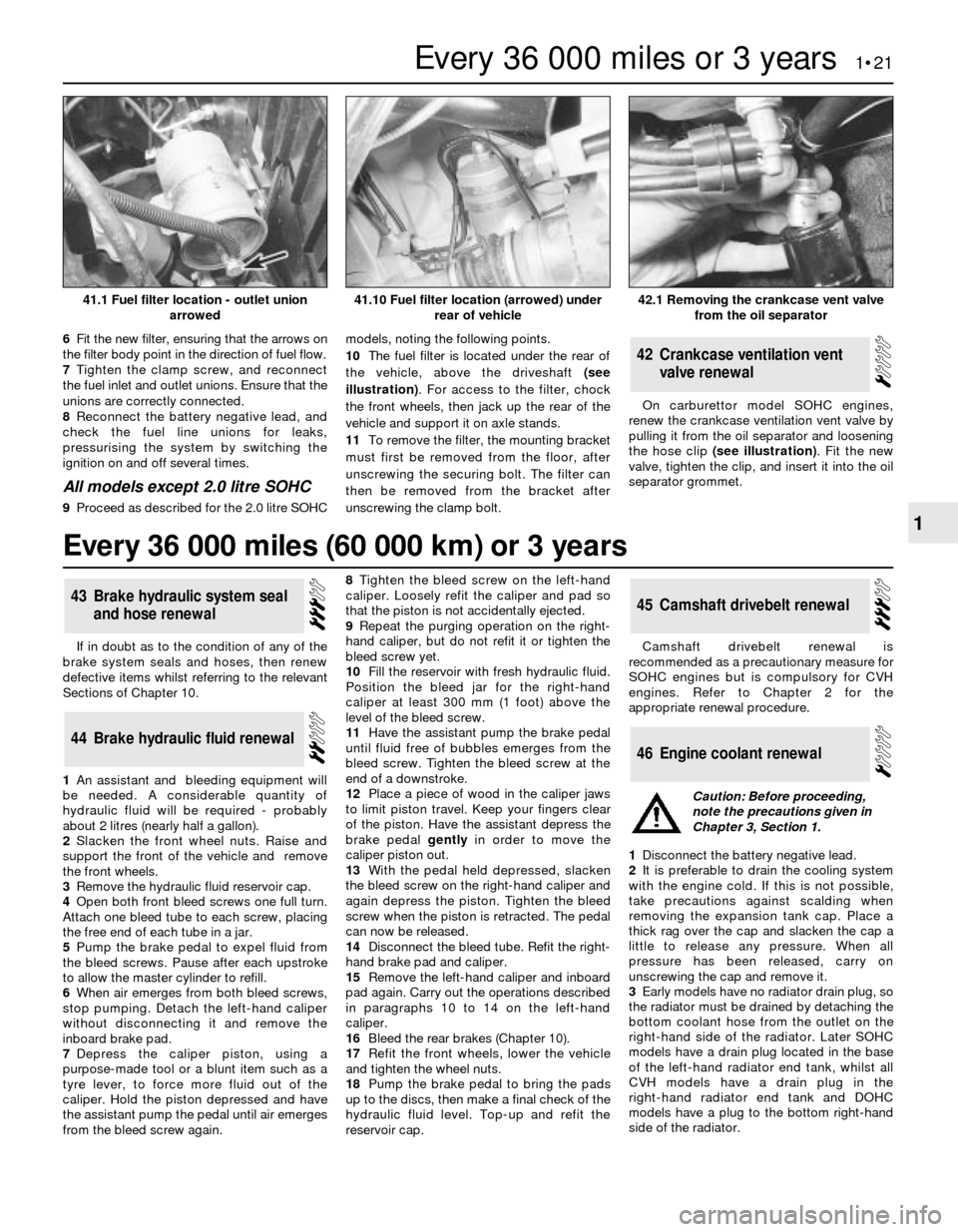
6Fit the new filter, ensuring that the arrows on
the filter body point in the direction of fuel flow.
7Tighten the clamp screw, and reconnect
the fuel inlet and outlet unions. Ensure that the
unions are correctly connected.
8Reconnect the battery negative lead, and
check the fuel line unions for leaks,
pressurising the system by switching the
ignition on and off several times.
All models except 2.0 litre SOHC
9Proceed as described for the 2.0 litre SOHCmodels, noting the following points.
10The fuel filter is located under the rear of
the vehicle, above the driveshaft (see
illustration). For access to the filter, chock
the front wheels, then jack up the rear of the
vehicle and support it on axle stands.
11To remove the filter, the mounting bracket
must first be removed from the floor, after
unscrewing the securing bolt. The filter can
then be removed from the bracket after
unscrewing the clamp bolt.On carburettor model SOHC engines,
renew the crankcase ventilation vent valve by
pulling it from the oil separator and loosening
the hose clip (see illustration). Fit the new
valve, tighten the clip, and insert it into the oil
separator grommet.
42Crankcase ventilation vent
valve renewal
If in doubt as to the condition of any of the
brake system seals and hoses, then renew
defective items whilst referring to the relevant
Sections of Chapter 10.
1An assistant and bleeding equipment will
be needed. A considerable quantity of
hydraulic fluid will be required - probably
about 2 litres (nearly half a gallon).
2Slacken the front wheel nuts. Raise and
support the front of the vehicle and remove
the front wheels.
3Remove the hydraulic fluid reservoir cap.
4Open both front bleed screws one full turn.
Attach one bleed tube to each screw, placing
the free end of each tube in a jar.
5Pump the brake pedal to expel fluid from
the bleed screws. Pause after each upstroke
to allow the master cylinder to refill.
6When air emerges from both bleed screws,
stop pumping. Detach the left-hand caliper
without disconnecting it and remove the
inboard brake pad.
7Depress the caliper piston, using a
purpose-made tool or a blunt item such as a
tyre lever, to force more fluid out of the
caliper. Hold the piston depressed and have
the assistant pump the pedal until air emerges
from the bleed screw again.8Tighten the bleed screw on the left-hand
caliper. Loosely refit the caliper and pad so
that the piston is not accidentally ejected.
9Repeat the purging operation on the right-
hand caliper, but do not refit it or tighten the
bleed screw yet.
10Fill the reservoir with fresh hydraulic fluid.
Position the bleed jar for the right-hand
caliper at least 300 mm (1 foot) above the
level of the bleed screw.
11Have the assistant pump the brake pedal
until fluid free of bubbles emerges from the
bleed screw. Tighten the bleed screw at the
end of a downstroke.
12Place a piece of wood in the caliper jaws
to limit piston travel. Keep your fingers clear
of the piston. Have the assistant depress the
brake pedal gentlyin order to move the
caliper piston out.
13With the pedal held depressed, slacken
the bleed screw on the right-hand caliper and
again depress the piston. Tighten the bleed
screw when the piston is retracted. The pedal
can now be released.
14Disconnect the bleed tube. Refit the right-
hand brake pad and caliper.
15Remove the left-hand caliper and inboard
pad again. Carry out the operations described
in paragraphs 10 to 14 on the left-hand
caliper.
16Bleed the rear brakes (Chapter 10).
17Refit the front wheels, lower the vehicle
and tighten the wheel nuts.
18Pump the brake pedal to bring the pads
up to the discs, then make a final check of the
hydraulic fluid level. Top-up and refit the
reservoir cap.Camshaft drivebelt renewal is
recommended as a precautionary measure for
SOHC engines but is compulsory for CVH
engines. Refer to Chapter 2 for the
appropriate renewal procedure.
1Disconnect the battery negative lead.
2It is preferable to drain the cooling system
with the engine cold. If this is not possible,
take precautions against scalding when
removing the expansion tank cap. Place a
thick rag over the cap and slacken the cap a
little to release any pressure. When all
pressure has been released, carry on
unscrewing the cap and remove it.
3Early models have no radiator drain plug, so
the radiator must be drained by detaching the
bottom coolant hose from the outlet on the
right-hand side of the radiator. Later SOHC
models have a drain plug located in the base
of the left-hand radiator end tank, whilst all
CVH models have a drain plug in the
right-hand radiator end tank and DOHC
models have a plug to the bottom right-hand
side of the radiator.
46Engine coolant renewal
45Camshaft drivebelt renewal
44Brake hydraulic fluid renewal
43Brake hydraulic system seal
and hose renewal
Every 36 000 miles or 3 years 1•21
1
42.1 Removing the crankcase vent valve
from the oil separator41.10 Fuel filter location (arrowed) under
rear of vehicle41.1 Fuel filter location - outlet union
arrowed
Caution: Before proceeding,
note the precautions given in
Chapter 3, Section 1.
Every 36 000 miles (60 000 km) or 3 years